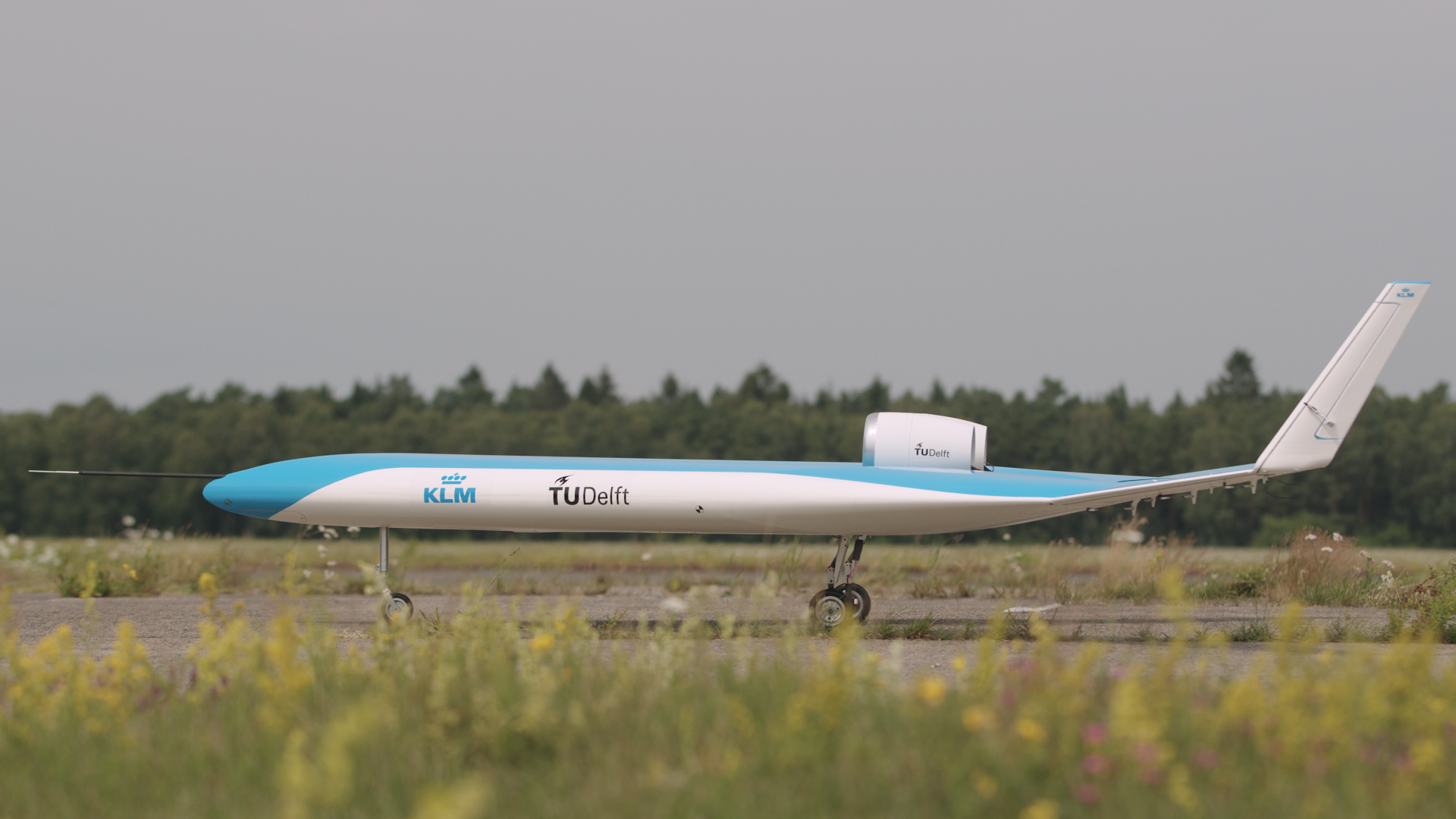Mye krutt skal åpenbart finnes opp på nytt. Boeing har hatt sine skalamodeller i luften i minst 15 år, og Airbus har for lengst testet det nye designet. Her en Boeing variant som ble utviklet i 2007:
(Red.)
KLM's Flying-V Scale Prototype Takes Its First Flight
X-48B
(Red.)
KLM's Flying-V Scale Prototype Takes Its First Flight

In a press release issued on Tuesday, KLM revealed that the scale
model prototype of the innovative Flying-V aircraft made its first flight last
month. KLM and Delft University of Technology have been working together on the
development for almost two years, and the successful maiden flight brings us a
step closer to radical new passenger aircraft design.
Development of the Flying-V
KLM issued a press release on September 1, announcing that the scale
prototype of its Flying-V had taken its first flight last month. A year and a
half ago, KLM Royal Dutch Airlines and Delft University of Technology (TU Delft)
unveiled their revolutionary Flying-V aircraft design. The prototype was
presented for the first time in October 2019, appropriately during KLM's 100th
anniversary.
The prototype has since been subjected to extensive wind tunnel and
ground tests and was finally declared ready to take to the skies.
The Flying-V is designed to be an extremely energy-efficient
long-haul plane. The fuel tanks, passenger cabin, and cargo hold are all
integrated into its wing structure. The spectacular V-shape formed by the wings
creates an improved aerodynamic shape and reduces the weight of the aircraft.
Computer calculations predict that the plane will reduce fuel consumption by 20%
compared to the most advanced aircraft flying today.
As the Flying-V was about to make its first flight, Pieter Elbers,
President and CEO of KLM, said,
"We were very curious about the flight characteristics of the
Flying-V. The design fits within our Fly Responsibly initiative, which stands
for everything we are doing and will do to improve our sustainability. We want a
sustainable future for aviation, and innovation is part of that. We are
therefore very proud that we have been able to achieve this together in such a
short period of time."
Flying-V makes its maiden flight
At an airbase in Germany last month, a team of engineers,
researchers, and a TU Delft drone pilot gathered for the first test flight.
According to TU Delft, the scale model weighs 22.5 kg (50 lb) and has a length
of 2.76 m (9.05ft) and a wingspan of 3.06 m (10 ft). It's fitted with two 4 kW
"ducted fan" engines, a drone control system, and 6 kg of lithium-polymer
batteries.
The goals of the test flight were to show that the prototype could
take off and land safely, and perform sustained flight involving a number of
maneuvers. The team was able to gather a great deal of flight data that enables
them to calculate what adaptations may need to be made as they prepare the
aircraft for new flight tests.
Test flight results
The maiden flight of the scale prototype was a success, but the team
found a couple of issues that will be adjusted for future flights. For example,
the aircraft's center of gravity was a little too much to the rear, meaning the
landing gear needs to be placed a little further forward. The plane also
experienced wobbling, which made it challenging to keep the wings level and
caused a rather rough landing. The data will be used to correct the
instability.
As the team moves forward with the development, they will also be
exploring alternative and sustainable methods of propulsion, possibly with
liquid hydrogen.
Flying-V Model Completes First Flight
Sjekk video her: https://tinyurl.com/y5e2x3h7
In partnership with Dutch airline KLM, Delft University of Technology (TU Delft) has successfully flown a scale model of its Flying-V airliner concept for the first time. The remotely controlled model weighs in at 22.5 kg (49.6 lbs.) with a 3.06-meter (10.04-foot) wingspan. The Flying-V, which “integrates the passenger cabin, cargo hold and fuel tanks in the wings,” is designed to be an energy-efficient long-haul aircraft.
“One of our worries was that the aircraft might have some difficulty lifting-off, since previous calculations had shown that ‘rotation’ could be an issue,” said project leader Roelof Vos. “The team optimized the scaled flight model to prevent the issue but the proof of the pudding is in the eating. You need to fly to know for sure.”
According to TU Delft, the Flying-V will offer a 20 percent reduction in fuel consumption over the Airbus A350 while carrying a comparable number of passengers. As previously reported by AVweb, KLM announced last year that it would be funding the development of the Flying-V. Along with KLM and TU Delft, Airbus is also involved with the project.Video: KLM Royal Dutch Airlines





Ingen kommentarer:
Legg inn en kommentar
Merk: Bare medlemmer av denne bloggen kan legge inn en kommentar.